Felixstowe Area “N” Gauge Group
JANUARY 2023 NEWSLETTER
NEWS FROM MEMBERS
Open Days and Exhibition
In the last few days, we found out that the Bury club have arranged an exhibition for Sat 25th March, clashing with our Open Day. As this would cause problems with Orwell supporting our show (plus members may wish to visit Bury) we have moved our Open Day to Sat 18th March.
So, the dates for our events for this year are;
Open Days: 18th March & 28th October, both at the Welcome Hall, Trimley St Mary.
Exhibition: 15th July, this is at the Memorial Hall, Trimley St Martin.
Also regarding our events, I have an appeal to members from both Kevin Hart and myself.
In order for these events to be successful (particularly the exhibition where people pay) we need the support of members, not just being there but offering layouts to show. I know that Kevin is struggling with layouts for the Open Day and for our exhibition I currently have one small layout that is complete / fully running. Offers of two other small layouts currently under repair / construction and a larger layout where track laying has not started yet. Clearly unless I have some more guarantees of completed layouts the exhibition might not go ahead.
Therefore, if you have any suitable layouts for the show or open days please get in contact with Kevin and myself.
RESURRECTED, REINCARNATED AND REMODELLED
Well. You know how it is, you start a layout then a change in lifestyle and re-marriage steps in to disturb the peace and tranquillity in the force of the universe and the destiny of your life’s pathway is well and truly screwed as they say. So, 11 years or so later after the shock of the mid-life crisis kicks in and you realise that you “messed up”, you then start to “re-boot” your unfinished plod along the path in life which you were travelling and make the sensible decision to resurrect the layout ! Allelujah !!
And, as the rebirth of enlightenment begins to break through in your dawn of new life, you begin to come to terms with what you have been missing and tell yourself to “enjoy life and do what the heck you want for a change”.
The layout in question is 2m long by 500mm wide which includes a traverser fiddle yard. It is based upon a Mid Dorset market town during the steam and early diesel era after the war, or it was……. The board one as it is now, awaiting scenery etc.
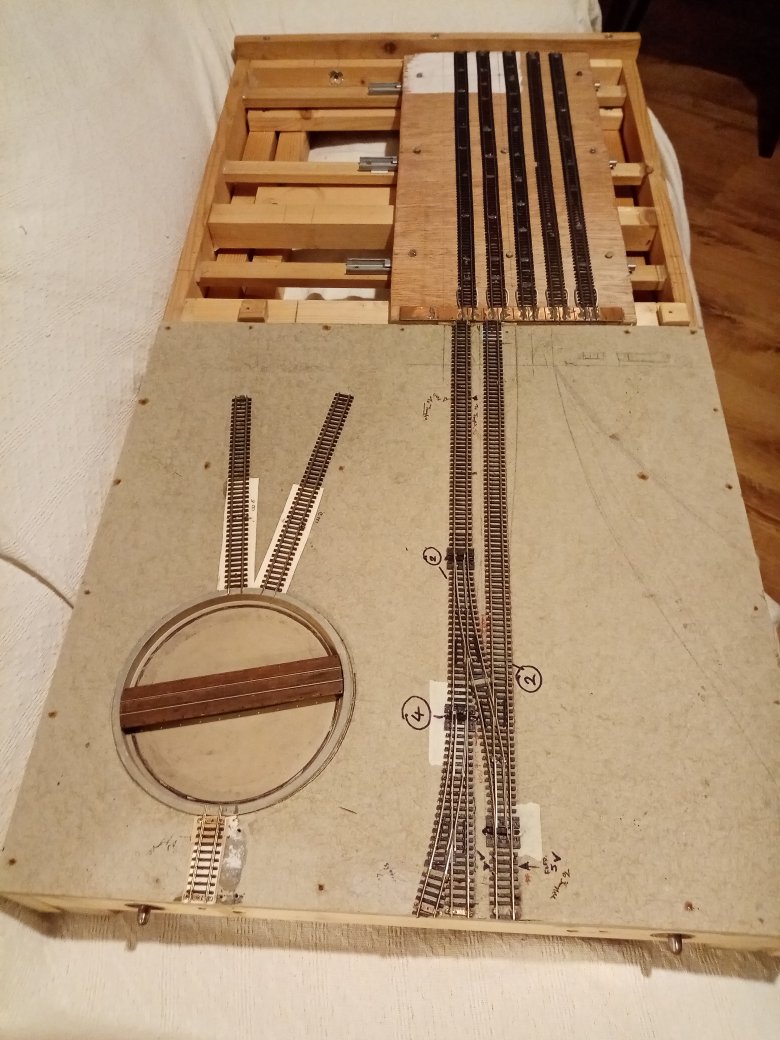
For a short while after restarting the layout this year, I decided that it needed a bit of a change and after the trip to the NEC show and visits to other smaller local shows, I decided to make some radical changes. Firstly, I wanted to add a small industrial area but realised that space on the board was not large enough when considering the models that I wanted to add. Then with renewed excitement, I made the bold decision to add a third board, which now extends the layout to 3m.
Planning went ahead and I got myself a roll of lining paper to begin drawing out the new design in full scale, so that I could work out the placement of track, station, goods yard, engine shed and so on, not forgetting the new industrial area.
Two more sidings were added, allowing an additional small platform to be included for a branch line train to leave from and larger wagon sidings. The goods shed area was extended along with the main station platforms, the access to the turntable was improved and the industrial area was much more workable with the added space and potential for modelling the scenery\buildings.
That’s the plan and so far, I am making quite good progress with the third board constructed awaiting track to be laid, and then wiring added. The original track on board two has been re-laid as needed and is in the process of being re-wired. I have made use of a three way point after a conversation with Chris Shum who gave me more confidence to do so, and the use of it has made quite a positive difference to the design of the layout overall.
Board one containing the fiddle yard and turntable has had a small section of track changed and the wiring upgraded to suit.
I use a control system which I am given to understand is sometimes referred to as “Cab control” whereby the main control panel can be set to operate one or more locos with any number of controllers (I have three) across the various track sections, each of which are coloured and work independently from whichever controller is selected. The control board is like most layout controls except for the selection of which controller operates it. Photo of the control panel is attached. The panel is still awaiting the final touches such as labelling and track diagrams but otherwise is now fully wired and operational. I recall reading many years ago a book by the well-known railway modeller and author Edward Beal about Cab Control, so the idea is not new, and still has a lot to offer if you are not interested in DCC.
I enjoy planning a layout as much as building it along with the models and I find drawing out the plan of the layout and the wiring quite therapeutic and aids building the structure easier and quicker with less chance of errors. Speaking of errors, should there be an electrical problem, it makes it easier to trace the issue when you have plans to hand. So far everything has gone very smoothly.
I have included some pictures of parts of the drawings made for the schematics of the wiring for the control panel switches, and points. The use of different coloured felt pens to identify the various coloured wires used makes things easier when wiring things up.
The switches for the track sectors are double pole double throw, six-way, thus enabling up to six controllers to be used on a layout requiring that many. Each track sector switch passes current from the selected controller to the track section and if several track sections are, for example, switched to controller 1, then a train is driven across all sectors easily and without affecting other trains on adjoining sections. Simple really, and I will bet most of you are aware of this anyway.
Points are fed from a common feed on the control board as normal with a capacitor discharge unit built into the control panel leading to the point switches. Power for the points and one controller are via 16v AC feed from a separate transformer.
The layout is still based on a Mid Dorset Market town which my son William and I have named “Moreton Regis”. It is an imaginary branch line off the Somerset and Dorset line around Shaftsbury with connections to Bournemouth, Weymouth, and Dorchester. The line gives good opportunity to see loco’s from various regions, namely LMS, Southern (LSWR), SDJR, the odd GWR railcar and push-pull units, along with excursions from further afield such as LNER.
The idea of an industry area came from my own place of work. I have decided to model a Yeast factory. The factory uses huge amounts of molasses and a set of tank wagons for delivering molasses seemed a good idea. The finished product, liquid yeast, is shipped out in road tankers these days, but could well have been transported by rail tankers to major bakeries and distilleries etc. So, therefore I have decided to have a set of tankers for deliveries too! Yeast is also supplied in “fresh” form” and “dried”, so box wagons etc are also going to be on the fleet. The process to produce yeast uses huge amounts of water and heat, so a location near a large water supply is needed which makes the location of the factory quite unique. Heat is produced by boilers which are fed by coal, so a small coal yard is included on the site to help power the boilers. A good excuse to use various named coal wagons on the layout. The Hunslett 0-6-0 by the N gauge society was too tempting not to miss, so I bought a white one which I will be adding some BFP (British Fermentation Products) transfers to, which I bought from a small manufacturer that produces them for model trucks.
Model buildings will be from Metcalfe with modifications and slight adaptions for the period and location. I will write more as the layout progresses.
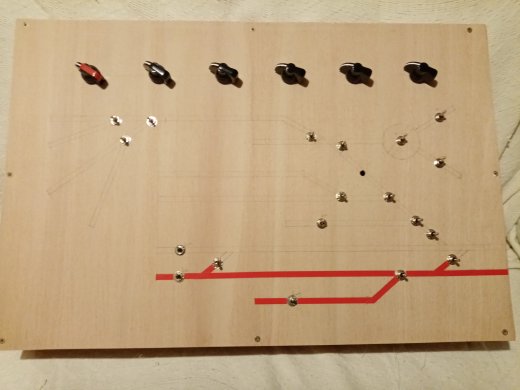
Control panel
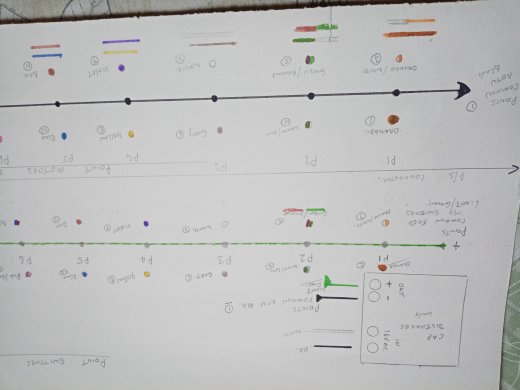
Points wiring schematic
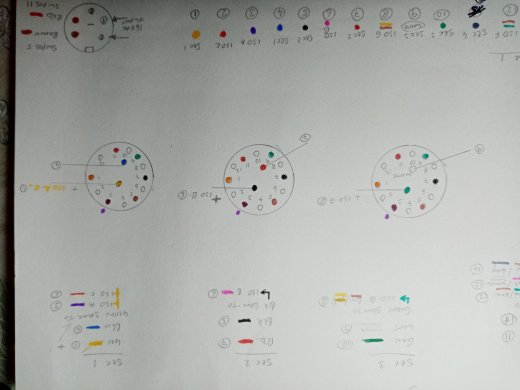
Sector switch wiring schematic
NEW BOOK
Here's a book on a subject very close to my heart, "The Book Of The Ivatt 4MTs" .
I got this from eBay for a tenner (other prices are available), the description said previously enjoyed, but you wouldn't know it and still has the new book smell (never mind glue, book sniffing, that's far more exciting...) it's in mint condition.
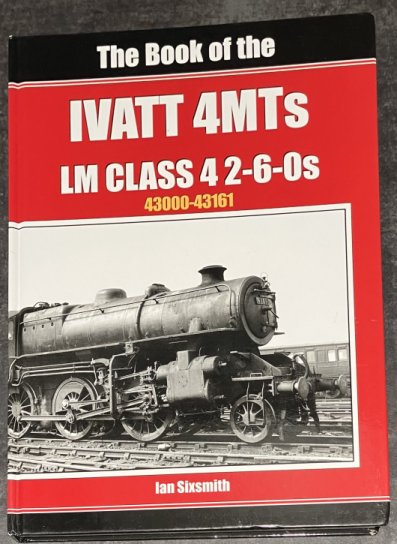
The Ivatt 4MT's are wonderful locomotives, the forerunners of the BR Standard Class 4.
These 'jack of all trades' locos worked all over the UK system and many ended up on the M&GNJR in the later years of the railway, before closure.
Every loco's history is detailed individually in this book as well as a complete history of the type in general.
Having been allocated to sheds at Kings Lynn, South Lynn, New England, Cambridge and Royston, it's feasible they worked in any part of our area, including Felixstowe!
When modelling the M&GN in N gauge, most other loco types are or have been available for the LNER and BR eras, but the Ivatt 4MT never has been.
Farish have done the BR Standard 4MT in N and Bachmann (all the same concern as we all know) have done the Ivatt 4MT in OO gauge, so surely an N gauge Ivatt can't be impossible??
I write to Farish on a regular basis about the inclusion of the Ivatt into their N gauge range, but so far the response has always been they are not saying yes and not saying no.....
So if anyone else wants one, an email to Farish can only help the cause.....
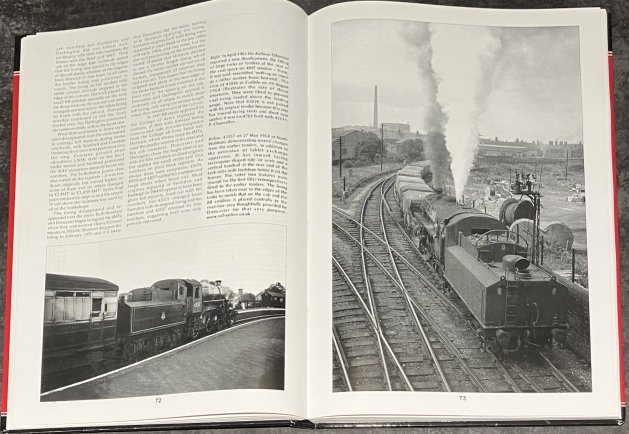
THE GERMAN ERA 1 LAYOUT
It’s taken some time to get to the stage of being able to run trains around on inside and outside lines of layout, which I and my father are building at the club. But recently I have managed to complete stage one of the fiddle yard at the rear, so that it can hold and control eight trains. Stage two, which will happen later down the line, will let the fiddle yard hold and control sixteen trains.
Last Thursday some of you saw that we did a running test on the fiddle yard, using some of the period stock we plan to run when it’s finished. I’m happy to say that, after fixing a small issue, all is working well. The linked point fire when asked, the line indication lights work perfectly and the trains run when released from their isolation sections.
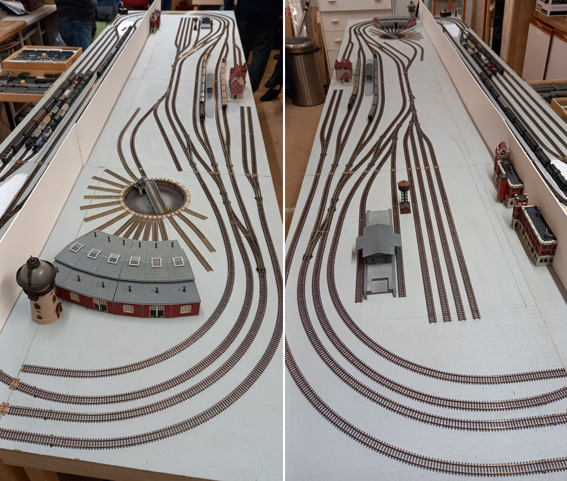
As well as a running session I was able to place out some of the buildings that we have planned to feature on the layout: the six-stall round house, two water towers, the station, a goods depot and two factories. These looked good in place and helped to give a starting impression of the scenic side. But there are many other buildings to be added, such as: a signal box, loading cranes, covered freight depot, platforms for the station, loading docks for the factories, and a bunch of small bits needed the fill out the scene of a station, marshalling yard and loco depot.
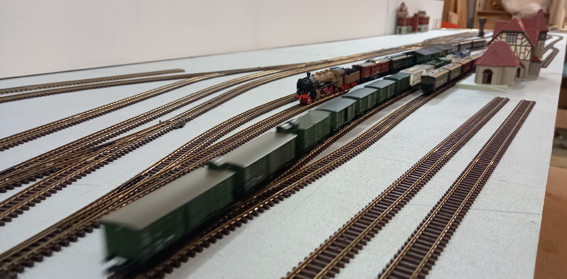
The next step is to get the layout on its side again and continue to add the point motors for the marshalling yard, the line crossings and the shuttle systems. That’s just another 28 points to go, so no worries… Its sooooo much wiring, but it will be worth it when is all running.
Other tasks we discovered when doing the running test, was that most of our locos need a part or full service. When we tried them, one or two were dry or didn’t like to move at all due to the oil/grease inside turned hard from drying out. So, a session or two of loco maintenance is on the cards.
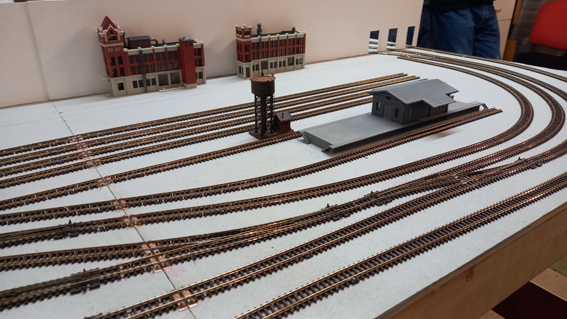

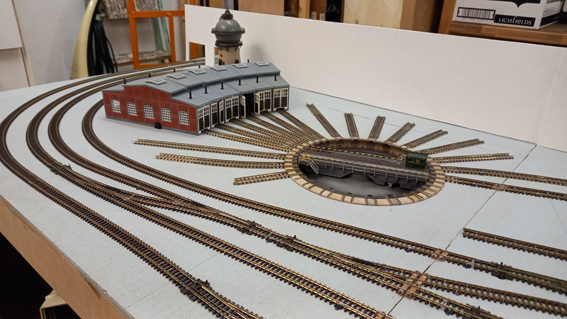
COLLIERY LAYOUT PROGRESS
I've been having a play around with various 'coal scatter' recently, for the surface of the colliery sidings.
Looking through my colliery and coalmine book that I showed here a few months back, you'd think that you can't really go wrong as there are so many different ground surfaces at these places, anything would do - sadly it's not that simple!
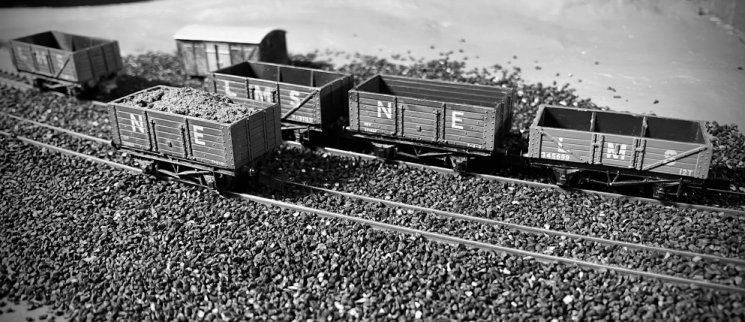
Coal clump size seems to be the biggest pitfall (no pun intended...), in the photo I've got down some small coal scatter from Javis Scenics.
It's a nice product, but the lumps are too large for what you'd find on the floor of a colliery.
I'll be trying something that can nearer be described as 'coal dust' next, I think that will be nearer the mark - I'll report my findings next month!
NEW TOYS
As expected, members have plenty of new models after christmas!

A new Graham Farish class 24 with some secondgand Colmans wagons
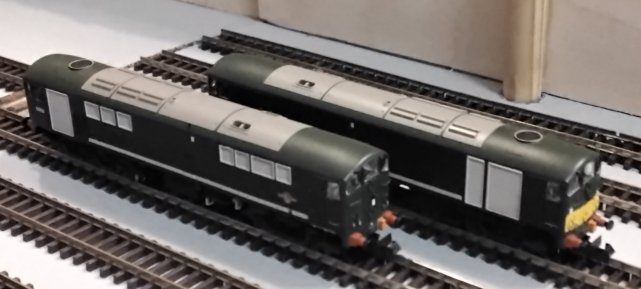

A pair of class 28s
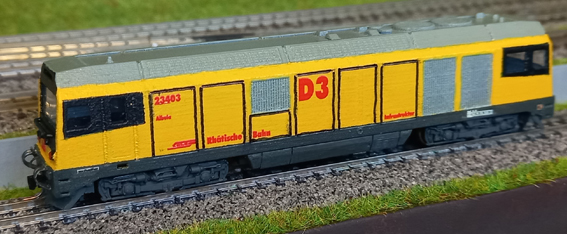
We managed to get a rare Swiss loco from eBay.
A 3D printed diesel for the metre gauge RhB, it’s on a converted N gauge Tomix chassis, to fit on 6.5mm Z gauge track. The Loco is used to pull infrastructure trains around at all times of year, such as snow ploughs, ballast wagons, overhead cabling trains and track tamping and rail installation machines.
I like the model, but feel I can do a better paint job and smooth the sides, so expect to see an article on this in the future.
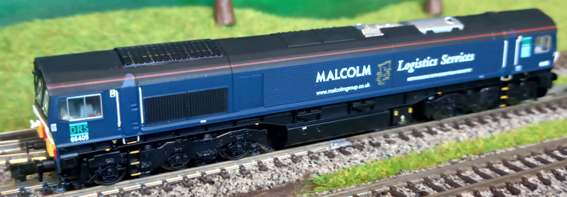
Dapol 66405 Malcolm Logistics.
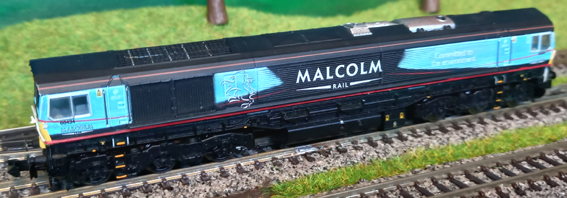
Dapol 66434 Malcolm Rail.

Dapol 66731 ‘Thank you NHS’ (A rare find).

Dapol 66789 GBRf.
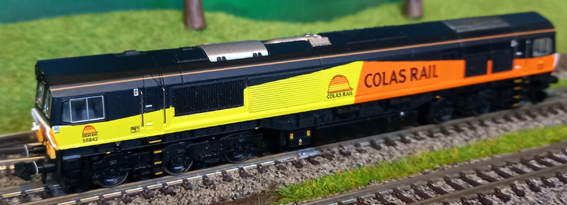
Dapol 66842 Colas Rail.

GRAFAR 66301 Fast line.
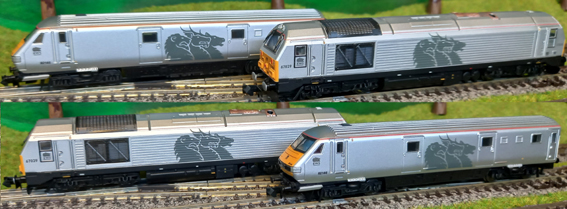
Dapol EWS 67 + DVT Business Train twin set.
They don’t make the three coaches to go between them, but we have some vinyls and are in the process of getting three donor mk3 coaches.
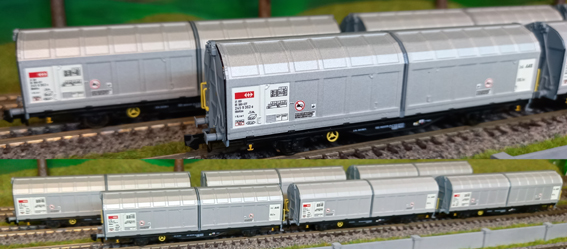
Six Fleischmann SBB Cargo Sliding Wall Wagons.
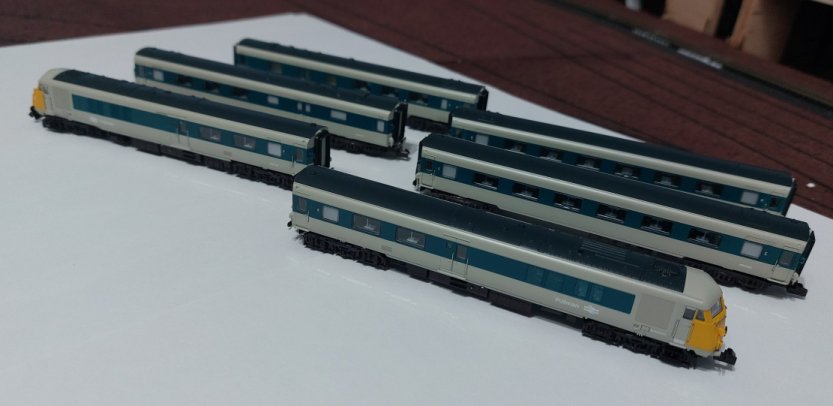
Western Pullman 6 car set in Grey-Blue from Farish.
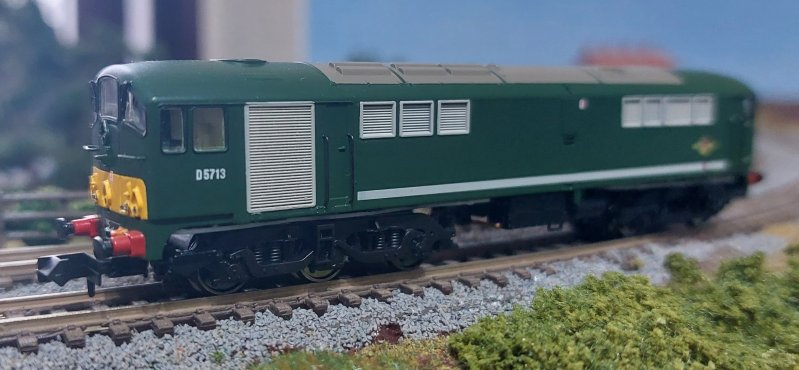
Another Rapido class 28, this time with dcc sound.
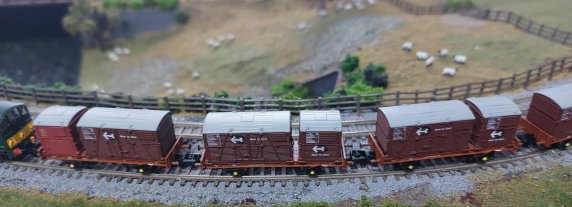
A triple set of Rapido Conflats to go with the Class 28.
In fact, there are 3 triples but I couldn't get them all in one picture.



























